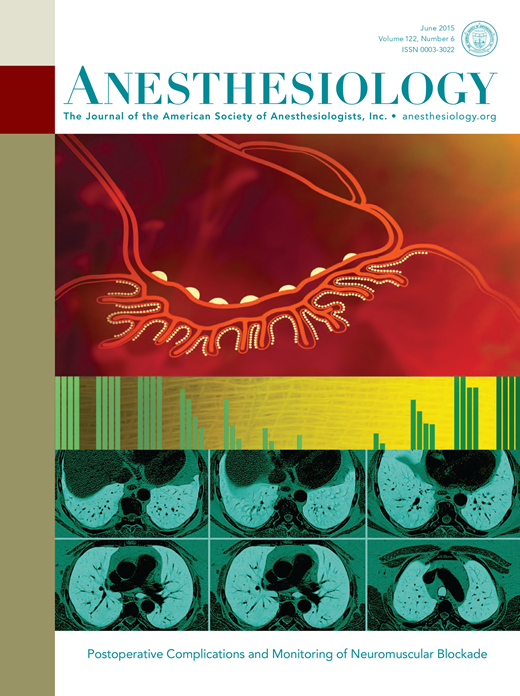Perioperative Nitric Oxide Conditioning Reduces Acute Kidney Injury in Cardiac Surgery Patients with Chronic Kidney Disease (the DEFENDER-trial): a Randomized Controlled Trial.
IF 9.1
1区 医学
Q1 ANESTHESIOLOGY
引用次数: 0
Abstract
BACKGROUND Postoperative Acute kidney injury (AKI) is a significant concern for cardiac surgery patients with chronic kidney disease (CKD). Effective pharmacological interventions to mitigate these risks are urgently needed. This study aimed to evaluate the efficacy and safety of perioperative nitric oxide (NO) administration in preventing AKI and limiting CKD progression in patients undergoing cardiac surgery. METHODS A total of 136 patients with CKD undergoing elective cardiac surgery with cardiopulmonary bypass (CPB) were randomized into two equal groups: the NO group (n=68), receiving 80 parts per million NO during the intraoperative period and for 6 hours post-surgery, and the control group (n=68), receiving a sham treatment. The primary outcome was AKI incidence within 7 days post-surgery. RESULTS AKI incidence was significantly lower in the NO group (16/68 patients, 23.5%) compared to the control group (27/68 patients, 39.7%) with a relative risk (RR) of 0.59 (95% CI 0.35-0.99; р=0.043). Six months post-surgery, the glomerular filtration rate was higher in the NO group (50 mL/min/1.73 m2 [45; 54]) compared to the control group (45 mL/min/1.73 m2 [41; 51], p=0.038). Postoperative pneumonia was significantly less frequent in the NO group: 10/68 (14.7%) vs 20/68 (29.4%) RR 0.5; (95% CI 0.25-0.99; р=0.039). NO administration was safe: methemoglobin and nitrogen dioxide levels remained within acceptable ranges, oxidative-nitrosyl stress did not increase, and there were no significant differences between the groups in blood transfusion requirements, platelet counts, or postoperative blood loss volumes. CONCLUSIONS Perioperative NO administration in CKD patients undergoing cardiac surgery with CPB is safe, reduces the incidence of AKI, and slows the progression of renal dysfunction.围手术期一氧化氮调节可减少心脏手术合并慢性肾病患者的急性肾损伤(defender试验):一项随机对照试验。
背景:术后急性肾损伤(AKI)是心脏手术合并慢性肾脏疾病(CKD)患者的一个重要问题。迫切需要有效的药物干预来减轻这些风险。本研究旨在评估围手术期一氧化氮(NO)在心脏手术患者预防AKI和限制CKD进展中的有效性和安全性。方法将136例择期心脏手术合并体外循环(CPB)的CKD患者随机分为两组:NO组(n=68),术中及术后6小时给予百万分之80的NO,对照组(n=68)给予假治疗。主要终点是术后7天内AKI发生率。结果NO组aki发生率(16/68例,23.5%)显著低于对照组(27/68例,39.7%),相对危险度(RR)为0.59 (95% CI 0.35-0.99;р= 0.043)。术后6个月,NO组肾小球滤过率较高(50 mL/min/1.73 m2;[54])与对照组(45 mL/min/1.73 m2;51], p = 0.038)。NO组术后肺炎发生率明显降低:10/68 (14.7%)vs 20/68 (29.4%) RR 0.5;(95% ci 0.25-0.99;р= 0.039)。一氧化氮给药是安全的:高铁血红蛋白和二氧化氮水平保持在可接受的范围内,氧化亚硝基应激没有增加,两组之间输血需求、血小板计数或术后失血量没有显著差异。结论CKD行心脏手术合并CPB患者术中给予NO是安全的,可降低AKI的发生率,减缓肾功能障碍的进展。
本文章由计算机程序翻译,如有差异,请以英文原文为准。
求助全文
约1分钟内获得全文
求助全文
来源期刊

Anesthesiology
医学-麻醉学
CiteScore
10.40
自引率
5.70%
发文量
542
审稿时长
3-6 weeks
期刊介绍:
With its establishment in 1940, Anesthesiology has emerged as a prominent leader in the field of anesthesiology, encompassing perioperative, critical care, and pain medicine. As the esteemed journal of the American Society of Anesthesiologists, Anesthesiology operates independently with full editorial freedom. Its distinguished Editorial Board, comprising renowned professionals from across the globe, drives the advancement of the specialty by presenting innovative research through immediate open access to select articles and granting free access to all published articles after a six-month period. Furthermore, Anesthesiology actively promotes groundbreaking studies through an influential press release program. The journal's unwavering commitment lies in the dissemination of exemplary work that enhances clinical practice and revolutionizes the practice of medicine within our discipline.
 求助内容:
求助内容: 应助结果提醒方式:
应助结果提醒方式:


